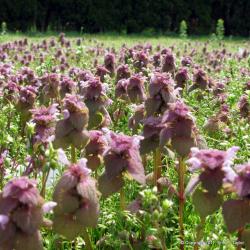Purple deadnettle


Purple deadnettle (Lamium purpureum L.)
Life Cycle:
Winter annual. Primarily emerges in the fall, flowering and seed set begins in early spring. Plants die with hot, dry weather in late-May and June.
Emergence:
Primarily emerges from soil depth of 1-inch or less. However, emergence can occur from 2 1/2-inch soil depths.
Seed:
Production Range: Produces 27,000 seeds per plant without competition.
Dispersal Mechanisms: None.
Longevity: Moderate to very long persistence - about 20% of seed was lost from the soil seed bank each year in a 6 year experiment. However, there have been reports of purple deadnettle seed still viable after 660 years.
Dormancy: Initially dormant, high summer temperatures break dormancy and seed germinated in the fall.
Competitiveness:
Not very competitive with small grains.
Preferred Soil/Field Conditions:
Thrives in nutrient-rich and mildly humic, loamy or sandy-loam soils.
Management:
Biological
Predation/grazing: No information.
Decay: No information.
Mechanical
Tillage: Purple deadnettle is readily controlled by tillage in the late-fall or early spring.
Rotary Hoeing: Primarily a no-till weed, not likely present at time of hoeing.
Flaming: No information.
Cultural
Crop rotation: Typically a problem of small grains, alfalfa and no-tillage systems. Planting small grains at higher populations will suppress purple deadnettle.
Planting date: Tillage in the spring and planting later (mid-May) will reduce purple deadnettle infestations.
Chemical
Application timing and effectiveness: Easily controlled with herbicides. Fall and early spring herbicide applications are generally most effective and may also suppress seed production. Please refer to E-434, "MSU Weed Control Guide for Field Crops," for herbicide recommendations.
Additional Information
Can serve as an alternate host for soybean cyst nematode.



 Print
Print Email
Email